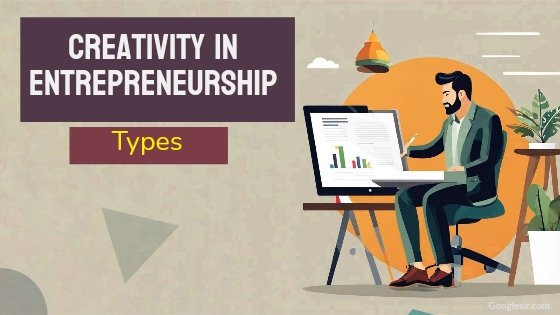Creativity is the lifeblood of entrepreneurship, the driving force behind innovation, and the cornerstone of progress in the business world. As entrepreneurs navigate the ever-evolving landscape of commerce, they rely on their creative prowess to carve out new niches, disrupt markets, and realize their visions. However, creativity is not a monolithic concept; it comes in various forms, each with its own unique attributes and applications in the entrepreneurial context.

Creativity in entrepreneurship is the ability to generate innovative ideas, approaches, and solutions to identify and address business challenges and opportunities. It’s the driving force behind the conception, development, and growth of new ventures.
Entrepreneurs who possess creativity think beyond conventional boundaries, continuously seek novel ways to add value to their target markets, and are unafraid of taking calculated risks.
This creative mindset extends across various dimensions, from product and service innovation to business model design, marketing strategies, and problem-solving.
Creative entrepreneurs can differentiate their businesses from competitors. This distinctiveness can be a significant competitive advantage, as it attracts customers and sets the company apart in crowded markets.
What are the Types of Creativity in Entrepreneurship?
The following are the different types of creativity in entrepreneurship, exploring how they manifest when to harness them, and their profound impact on business success.
1. Divergent and Convergent Creativity
Divergent creativity is often the initial spark in the entrepreneurial journey. It involves diverging from traditional thinking patterns to generate a plethora of ideas.
Entrepreneurs proficient in divergent creativity are skilled at ideation, brainstorming, and exploring unconventional solutions. They foster an environment where wild ideas are encouraged and brainstorming sessions are open-ended.
On the flip side, convergent creativity is the process of filtering and refining these divergent ideas into a focused, actionable plan. It requires critical thinking, prioritization, and decision-making.
Effective entrepreneurs use convergent creativity to sift through the creative chaos, selecting the most viable and promising concepts to pursue. Striking the right balance between these two modes of creativity is pivotal for transforming imaginative concepts into practical, market-ready products or services.
2. Adaptive Creativity
Adaptive creativity is a dynamic trait that separates thriving entrepreneurs from those who stagnate. In an ever-evolving business landscape, adaptability is paramount. This type of creativity entails recognizing when a pivot or course correction is necessary and being willing to implement it swiftly.
Adaptive entrepreneurs remain open to market feedback, emerging trends, and technological advancements, allowing them to adjust strategies, products, or services to meet changing demands.
To illustrate, consider how Netflix transitioned from a DVD rental service to a global streaming platform. Their adaptive approach to the shift in consumer behavior revolutionized the entertainment industry.
They understood the importance of staying ahead of the curve, embracing new technologies, and adapting to an increasingly digital world.
3. Disruptive Creativity
Disruptive creativity is about rewriting the rules of the game. Entrepreneurs who wield disruptive creativity identify gaps in the market and develop innovative solutions that challenge established norms and industries.
This type of creativity can lead to radical market transformations and the displacement of incumbents.
Take Airbnb, for instance. By capitalizing on the sharing economy and providing travelers with unique lodging options in the homes of ordinary people, Airbnb disrupted the traditional hotel industry.
They redefined the way people travel and accommodations are booked, all through the lens of disruptive creativity. Entrepreneurs who aim to disrupt must be prepared for resistance from existing players and navigate regulatory challenges.
4. Aesthetic Creativity
Aesthetic creativity is not just about appearances; it’s about creating an emotional connection between products or services and consumers.
It’s crucial in industries where aesthetics significantly influence consumer choices, such as fashion, interior design, and luxury brands. Entrepreneurs who excel in this type of creativity understand that design is not just superficial but a core component of their value proposition.
Apple’s success largely stems from its mastery of aesthetic creativity. Their sleek, minimalist designs not only appeal to consumers’ sense of style but also create a sense of prestige and quality.
Such aesthetics are carefully crafted to evoke emotions and desire, demonstrating how aesthetic creativity can be a powerful tool for attracting and retaining customers.
5. Experiential Creativity
Experiential creativity is all about crafting memorable and immersive experiences for customers. It extends beyond the product or service itself to encompass every touchpoint a customer has with a brand.
Entrepreneurs who prioritize experiential creativity recognize that positive experiences not only drive customer loyalty but also generate word-of-mouth referrals.
Disney, often cited as a leader in experiential creativity, is a prime example. From the moment visitors step into a Disney park, they are transported into a world of magic and wonder. The attention to detail, immersive storytelling, and exceptional service all contribute to an unforgettable experience.
Entrepreneurs in industries such as hospitality, entertainment, and tourism must focus on creating environments that captivate and delight their customers, as these experiences become a brand’s most potent marketing tool.
6. Collaborative Creativity
Collaborative creativity underscores the importance of working with diverse teams, experts, and partners to foster innovation.

Entrepreneurs who excel in this type of creativity create an environment where cross-functional collaboration flourishes, allowing for the fusion of diverse perspectives and expertise.
Silicon Valley’s success is partially attributed to collaborative creativity. Tech giants like Google and Facebook encourage open innovation by providing employees with a platform to propose and develop new ideas.
Their “hackathons” and collaborative workspaces enable employees to contribute their unique insights, resulting in the creation of groundbreaking products and services.
7. Frugal Creativity
Frugal creativity is all about achieving more with fewer resources. Entrepreneurs who embrace this type of creativity excel at cost-effective innovation and efficiency.
In resource-constrained environments, frugal creativity can be the difference between survival and failure.
The Indian conglomerate, Tata Group, epitomizes frugal creativity. They have a track record of developing innovative and affordable solutions, such as the Tata Nano, the world’s cheapest car at the time of its launch.
By optimizing resources and focusing on cost-effective manufacturing processes, Tata has been able to penetrate price-sensitive markets successfully.
8. Inclusive Creativity
Inclusive creativity is rooted in designing products and services that cater to diverse and underserved populations. It requires entrepreneurs to prioritize accessibility, diversity, and social responsibility in their business strategies.
Inclusive entrepreneurs recognize the importance of addressing the needs of marginalized or underrepresented groups.
Microsoft’s Xbox Adaptive Controller exemplifies inclusive creativity. Designed for gamers with limited mobility, this controller includes a range of accessibility features that make gaming more inclusive. Microsoft’s commitment to inclusivity not only broadens its customer base but also fosters goodwill and strengthens its brand’s social impact.
9. Technological Creativity
Technological creativity revolves around harnessing cutting-edge technologies to innovate and disrupt industries.
Entrepreneurs in tech-intensive fields like artificial intelligence, biotechnology, and blockchain rely heavily on this type of creativity to push the boundaries of what’s possible.
SpaceX, founded by Elon Musk, is a prime example of technological creativity in action. By developing reusable rockets and striving for interplanetary travel, SpaceX has redefined space exploration.
Their groundbreaking achievements have reshaped the aerospace industry, demonstrating the immense potential of technological creativity.
10. Social and Environmental Creativity
Social and environmental creativity emphasizes the integration of social and environmental responsibility into business models. Entrepreneurs who embrace this type of creativity seek to address pressing global challenges while maintaining profitability.

The Danish company Novozymes embodies social and environmental creativity. They specialize in bio innovation, using enzymes and microorganisms to reduce environmental impact in industries like agriculture and energy.
Novozymes’ work not only enhances sustainability but also aligns with growing consumer demands for eco-friendly solutions.
11. Narrative Creativity
Narrative creativity focuses on crafting compelling stories around a product, service, or brand. Entrepreneurs who excel in narrative creativity understand the power of storytelling in building emotional connections with customers and shaping brand identities.
The outdoor clothing brand Patagonia is renowned for its narrative creativity. They use storytelling to convey their commitment to environmental conservation and social responsibility.
Through campaigns and initiatives, Patagonia weaves a narrative that resonates with environmentally conscious consumers and motivates them to support the brand’s mission.
Conclusion:
Creativity in entrepreneurship is the driving force behind entrepreneurial innovation and success. Entrepreneurs harness different types of creativity to navigate the complexities of the business world, adapt to changing circumstances, and create value for their customers.
Whether it’s divergent and convergent creativity, adaptive and disruptive creativity, or any of the other types discussed here, each form of creativity contributes to the richness and diversity of the entrepreneurial ecosystem.
By understanding and leveraging these various types of creativity, entrepreneurs can chart a path toward sustained growth and lasting impact in an ever-evolving marketplace.

